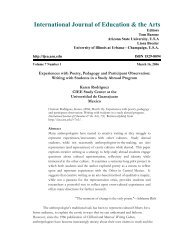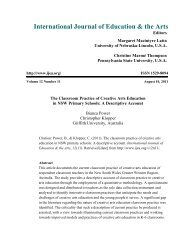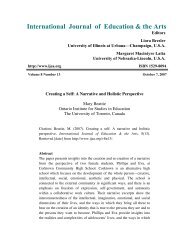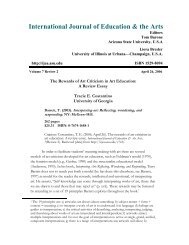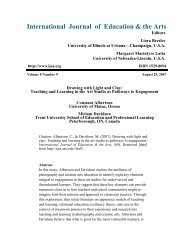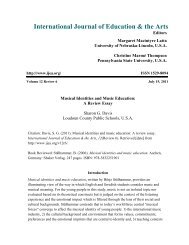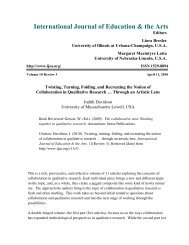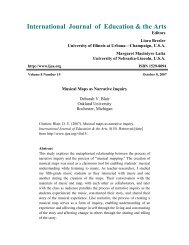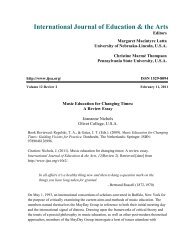On Empathy: The Mirror Neuron System and Art Education
On Empathy: The Mirror Neuron System and Art Education
On Empathy: The Mirror Neuron System and Art Education
Create successful ePaper yourself
Turn your PDF publications into a flip-book with our unique Google optimized e-Paper software.
IJEA Vol. 10 No. 15 - http://www.ijea.org/v10n15/ 10<br />
would suggest that mirror neurons of classically-trained ballet dancers were more likely to<br />
resonate when observing Brazilian dancers perform the unfamiliar Capoeira style than when<br />
observing the Brazilian dancers perform classical ballet. Indeed, it seems likely that the ballet<br />
dancers would perceive <strong>and</strong> resonate with an authenticity, or in Iacoboni’s (2007) words,<br />
“underst<strong>and</strong> a kind of harmony” between the Brazilian dancers <strong>and</strong> their native Capoeira.<br />
Similarly designed studies of the skills <strong>and</strong> activities performed in the studio classroom might<br />
yield similar results. For instance, it seems likely that the mirroring cells of students skilled in<br />
painting, say, would be more resonant when observing a painter demonstrating painting<br />
techniques than when observing a ceramic artist demonstrating wheel techniques. But it also<br />
seems likely that these students’ cells would be more activated when watching the ceramicist<br />
on the wheel than when watching this clay artist at the familiar easel. Painting students would<br />
likely underst<strong>and</strong> a resonant harmony <strong>and</strong> authenticity between the painter <strong>and</strong> the painting<br />
techniques <strong>and</strong> between the ceramic artist <strong>and</strong> the wheel techniques. Although not yet<br />
confirmed by scientific means, this kind of perceived <strong>and</strong> resonant authenticity—Iacoboni’s<br />
“harmony”--is recognizable, particularly among those in the arts community, <strong>and</strong> would be<br />
important in an empathic art education.<br />
Toward an <strong>Art</strong> <strong>Education</strong> of <strong>Empathy</strong><br />
<strong>Empathy</strong> can surely be found in art classrooms around the world, but too often, it is merely a<br />
happenstance, the resulting by-product or incidental outcome of the learning process. Any<br />
movement toward an art education of empathy must begin with a commitment to empathic<br />
learning, stated unambiguously as a goal of instruction. In this art education, empathy <strong>and</strong><br />
Noddings’ notion of caring would be conceived of as one sturdy leg in the tripod that, along<br />
with cognitive growth <strong>and</strong> sociocultural awareness, holds up a humanistic education preparing<br />
students for active membership in the pluralistic communities of the 21 st Century. Teachers<br />
would value as empathic <strong>and</strong> educative those connections that develop, say, between the<br />
kindergarten child <strong>and</strong> the bright, rapturous colors of his first easel painting, or between a high<br />
school student <strong>and</strong> her classmates with whom she shares the Cezanne still life that so inspires<br />
her. Understood in the context of the workings of the mirror neuron system, such connections<br />
would be appreciated not only for their resonance <strong>and</strong> authenticity, but also, for their potency<br />
in engendering meaning <strong>and</strong> integrating the dimensions of the self-in-relation-to-other.<br />
Ultimately, they would be consciously promoted for the educational benefits bestowed upon<br />
the classroom community <strong>and</strong> beyond.<br />
Encompassing the worlds of objects <strong>and</strong> others, this art education digs into neuroscientific<br />
research for what is revealed about the strength of the connections between empathic<br />
underst<strong>and</strong>ing, emotional intelligence, <strong>and</strong> cognitive growth that are made in <strong>and</strong> through the<br />
resonant body, particularly as this body resonates along with the bodies of other resonant




